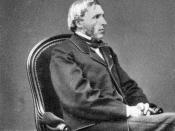Avogadro's Principle
According to Atkins and Jones, Avogadro's Principle states that the "molar volume, Vm, of a substance--any substance, not only a gas, is the volume it occupies per mole of its molecules." This principle is also expressed mathematically in the equation Vm = V/n where V is the volume of a sample and n is the amount, in moles, of molecules the sample contains.
Avogadro's principle was developed to respond to the conflicting conclusions of two chemists of the early 1800s: Joseph Louis Gay-Lussac and John Dalton. Dalton, founder of the Law of Multiple Proportions and the Law of Definite Proportions, was established in the emerging chemistry field. In 1808, when the terms of atoms and molecules were not clearly identified, Dalton proposed in his publication, New System of Chemical Philosophy, that atoms were the combining units in chemical reactions, and when two elements combined forming a compound, only one atom from each element combined.
However, based on experimental evidence gathered working with gasses at the time, Gay-Lussac proposed a theory of combining gas volumes: when two gasses form a unique product, they combine in ratios of whole numbers. For example, combining two volumes of hydrogen gas and one volume of oxygen gas produces two volumes of water. If this reaction had been in accordance with Dalton's theory, only one volume of water would be produced and a volume of hydrogen would be left over. In an effort to protect his own atomic theory, Dalton tried to discredit Gay-Lussac.
Reading both of the chemists' works, Avogadro tried to settle the disagreement. In 1811, Avogadro, in his published article, Journal de physique, made the distinction between the atom and molecule, and wrote that Dalton had made the error of equating a molecule with an atom. Avogadro proposed that a gas...


